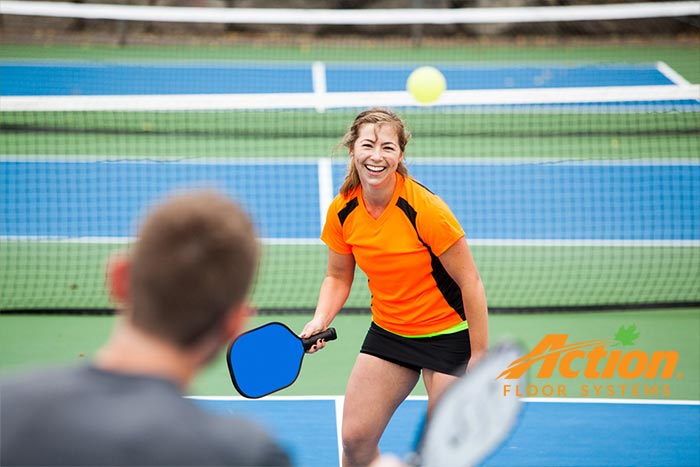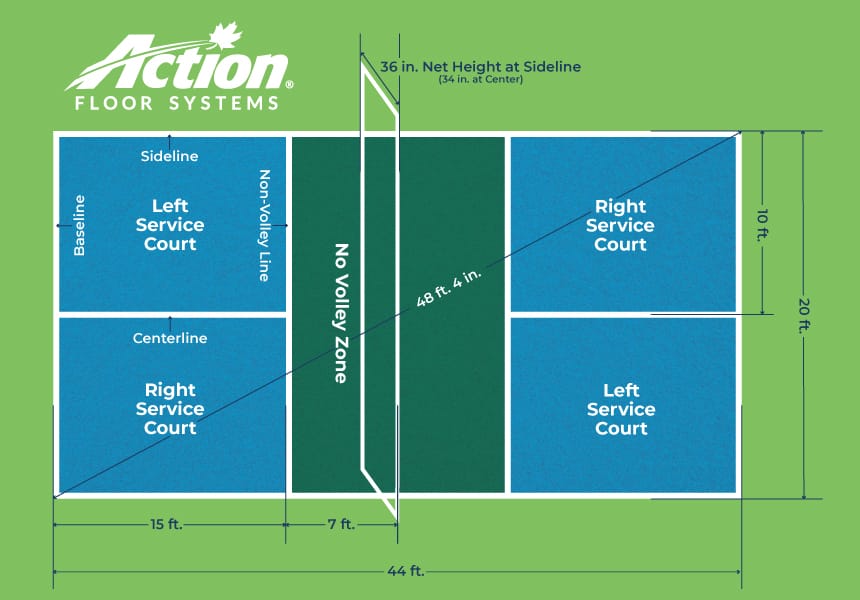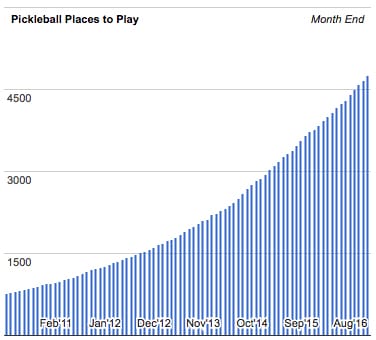
It’s a game with a funny name, but the massive growth of pickleball’s popularity is no joke.
Pickleball is nearing its 60th anniversary, and it’s come a long way from a homemade game over the decades. It’s a hybrid of tennis, badminton, and ping-pong that is played in parks, physical education programs, and retirement communities all over the country.
An NBC Nightly News report even declared pickleball the “fastest-growing sport in America.”
If you are designing or managing a recreation facility, you probably have some questions. Should you make room for pickleball courts in your space? What are the dimensions of a pickleball court? Here’s a closer look at a game many of its fans call “addictive.”
The Pickleball Story
Most sports originate from humble beginnings. As the story famously goes, John Naismith hung peach baskets inside a YMCA gymnasium one rainy day and basketball was born.

Pickleball inventor, Joel Pritchard
Pickleball was born during the summer of 1965, almost as a happy accident. Joel Pritchard, a congressman from Washington State, and his friend, Bill Bell, wanted to play badminton with their families because the kids were sitting around doing nothing. However, since they were missing a shuttlecock, they decided to get creative.
According to the USA Pickleball Association (USAPA), the families used a Wiffle ball with ping-pong paddles and decided to lower the badminton net to three feet in height. Eventually, rules were developed, larger wooden paddles were handcrafted, and a permanent court was set up in a neighbor’s yard.
The story is often told that the Pritchards named the game after their dog, Pickles. But, the family has set the record straight. Pickleball predates Pickles the dog, who was named after the game.
“Nobody remembers how it came to be called ‘pickleball,’ but I think somebody needed a reason why it had that name and the dog story sounded good and eventually stuck,” Joel’s son, Frank Pritchard, said in 2005.
A decade after that first game, Tennis magazine wrote about the emergence of pickleball and the first-known pickleball tournament took place in 1976. Pickleball continues to grow—but, more on that later.
Pickleball Court Dimensions: How Big is a Pickleball Court?
Pickleball is played on a surface that looks a lot like a badminton court with dimensions of 20’ by 44’. Markings are similar to a tennis court, except the outer sections of the pickleball court are split in half instead of the portion adjacent to the net. The recommended run off for the courts is 5’ on each side and 8’ on the ends making the ideal space 30’x60’ for the full playing area.
Review the graphic below for a full breakdown of pickleball court measurements:

Other Pickleball Basics
Serves are hit underhand, must clear the non-volley zone (commonly referred to as “The Kitchen”, and the paddle should make contact with the ball from below the waist. Each side lets the ball bounce once after a service before volleying can begin. This is what’s known as the “double bounce rule.”
Only the serving team can score points, and both members of a doubles team are given a chance to serve. The serving team switches sides of the court each time a point is scored. When the serving team commits two faults (one by each player), service goes to the opposing team.
The Kitchen is a “non-volley zone,” which prevents players from smashing hits inside that area.
Pickleball games are played to 11 points, and teams usually need to win by two points. Find out more about the rules of the game in the video below or visit the USAPA’s pickleball rules summary page.
Who is Playing Pickleball?
Though pickleball is known as a sport for older generations, it’s popular for players of any age. Pickleball grew in 2021 to 4.8 million U.S. players, according to the 2022 Sports & Fitness Industry Association (SFIA). The age range with the most overall players is 18-34 years old, but players range from six years old to 65+.
One possible reason for its wide popularity is that the sport is similar to tennis but easier on the body. It’s fast-paced, but it’s also low impact and takes place on a smaller surface area, making it easier to play. Pickleball is accessible for players who are young enough to still be developing fine motor skills and those who are older or recovering from past injuries.
However, reduced impact does not mean that the sport of pickleball is injury-free. Read our other post to learn about common pickleball injuries and how to prevent them.
Growth of Places to Play Pickleball
Another reason for pickleball’s growth is that an increasing number of parks and recreation departments are adding courts and starting programs. There were 9,524 places to play pickleball in the U.S. and Canada as of 2021, an increase of 789 new locations that year!
To find a pickleball court in your area, or submit a pickleball court to the registry, visit Places2Play.

Choosing the Right Sports Surface for Pickleball Courts
If you think pickleball courts would make a nice addition to a park in your community, or if you’re planning a new outdoor recreation area, make sure you’re choosing the right surface and location.
In some cases, the parks and rec department chooses to use existing tennis courts and add pickleball lines. Four pickleball courts can fit nicely into the area used for one tennis court.
However, it’s important to note that there can be tension between the tennis and pickleball communities. Some tennis players feel pickleball infringes on their space. For that reason, you may want to plan for separate pickleball areas.
The Ideal Pickleball Court Surface
Action Floors offers Action Herculan® PB, which provides an eco-friendly cushioned court that has excellent shock absorption and can minimize the risk of injury. Action Herculan® PB can be used as an indoor or outdoor pickleball sports surface.
If you’re considering pickleball courts in an indoor facility and prefer the look of hardwood maple flooring, pickleball can also be played on our sports floor systems for squash and racquetball.
Have questions about pickleball courts? Need help finding a qualified sports flooring dealer in your area? Contact Action Floors today or give us a call at 800-746-3512.
You may be interested in these related topics:
- Rehabbing Your Court for Pickleball
- Pickleball Courts | Specifying the Right Sports Surface
- How to Avoid Pickleball Injuries
- Pickleball Celebrates 55 Years



















